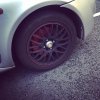Thinks to think about that haven't been mentioned (you know all this Dan!)...
Buying race-ish stuff (DS1.11) is exciting. Buying lesser stuff (1144, DS2500 etc) isn't. But then you have Tinder for "exciting"...
Number of additional Tinder dates you could go on with the money saved from buying DS2500 vs DS1.11...
Number of Tinder dates off-to-a-nerdy-start by the need to explain the low-speed squeeling in the car park outside Nandos...
Circuits - Blyton is actually really hard on brakes, although you're never stopping from much more than 100mph you only get 10-15 seconds of relatively low-speed cooling before you're hard on the brakes again. Rockingham for example you're stamping on the brakes from 120+ but prior to that you've got half a mile of oval for them to recover from the previous hard stop.
Temperature temperature temperature wear wear wear - wear rate increases with temperature, just like a drill bit. Use the same RPM at a lower temperature and you drill a hole in the same amount of time but with less wear on the tool. Same is true of brake pads. Assuming they're in their operating window (graphs of mu vs temp etc) you'll stop equally as well but with less wear if you can run the pads cooler.
Kinetic energy being 1/2mv^2 - I guess you're middle of the road, medium mass & medium velocity? Something like Cub's supercharged flamer (high v due to plenty of power & high m due to not being stripped) is probably one of the worst case Clios and asks the most of the pads/callipers/fluid/discs etc.
Tyres - with semi slicks you remove the same amount of total energy as road tyres (there's no "t" for time in 1/2mv^2 etc) but at a higher rate. So you either need to spend more on pads to deal with higher average temperatures, or improve cooling and keep the lesser (cheaper) pads.
Fluid - amazed no-one's mentioned this, how do you know it's the pads fading not the fluid boiling? Presume the pedal always had the similar travel, just became less effective...
Swapping between road & track pads each time is a royal PITA because the difference in pad thickness inevitably means you have to top-up every time you put thinner pads in. Not to mention if it's raining :L
At least 4 or 5 of those can be solved/improved not by spending a couple of hundred on pads (sorry George! :tongueout: ), but by putting a bit of thought into cooling. Granted, packaging is tight on Clios and the lack of daytime-fog-lights might reduce the Tinder success rate.
Fluid > cooling > then evaluate whether you still need to spend £200 every time you replace pads.


